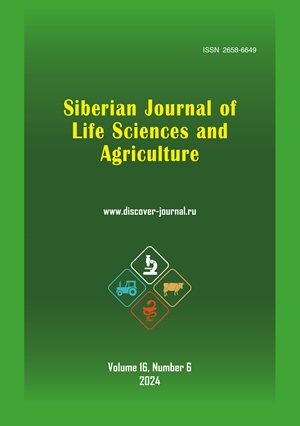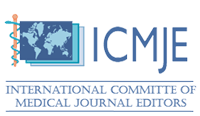УЛЬТРАСТРУКТУРНАЯ ОРГАНИЗАЦИЯ МАТРИКСА БИОПЛЕНКИ BACILLUS SUBTILIS В СТАЦИОНАРНОЙ ФАЗЕ
Аннотация
Обоснование. Эколого-географические условия места обитания микроорганизмов (МО) могут влиять на ультраструктурную организацию матрикса их биопленки и накопление в ней различных биологических активных соединений. Знание подобной организации у арктических палеобактерий крайне важно для изучения, основанных на сложных генетических программах, механизмов биосинтеза и дисперсии образуемых ими биопленок.
Цель. Продемонстрировать возможности и показать основные технические достижения трансмиссионной электронной микроскопии (ТЭМ) в области изучения матрикса биопленки палеобактерии рода Bacillus sp. штамма В1М выделенного из обводненных дисперсных пород, перешедших в мерзлое состояние.
Материалы и методы. Объект исследования – МО рода Bacillus выделенный из обводненных дисперсных пород, перешедших в мерзлое состояние и задепонированный в DDBJ/EMBL/GeneBank (№ AB178889, идентификационный № 20040510203204.24251). Исследования ультраструктур клеток выполняли анализируя их ультратонкие срезы. Визуализация ультратонких клеточных срезов осуществлялась на трансмиссионном электронном микроскопе JEM-1011 (“JEOL”, Япония) при ускоряющем напряжении 80 кВ. Значения кортизолподобного стероида, серотонинподобного и дофаминподобного пептидов определяли при помощи технологии ИФА. Статистический анализ данных производился посредством использования программ «IBM SPSS Statistics 21» и Microsoft Excel.
Результаты. Выявлено, что структурная гетерогенность характерна для организации матрикса биопленки палеобактерий рода Bacillus. На клеточных срезах отмечаются контактирующие между собой образования, в виде длинных туннельных нанотрубок с внутренним каналом. Поверхность МО покрыта многочисленными цитоплазматическими микроворсинками. Установлено, что клеточная стенка относительно проницаема. Вокруг бактериальных клеток имеется множество круглых везикул, окруженных мембранами. МО активно продуцируют кортизолподобный стероид, серотонинподобный и дофаминподобный пептиды.
Заключение. Применение ТЭМ позволило выявить и проанализировать ультраструктурную организацию матрикса биопленки Bacillus sp. штамма В1М выделенного из обводненных дисперсных пород, перешедших в мерзлое состояние.
Информация о спонсорстве. Исследования выполнялись в рамках госзадания на 2021-2030 годы (Пространственно-временные явления и процессы, происходящие в водах суши Сибири в условиях современного техногенеза и изменения климата (Приоритетное направление 1.5.11. Программа 1.5.11.1)).
EDN: FQUSQS
Скачивания
Литература
Список литературы
Воробьева Л.И., Ходжаев Е.Ю., Новикова Т.М., Мулюкин А.Л., Чудинова Е.М., Козлова А.Н., Эль-Регистан Г.И. Стрессопротекторное и перекрестное действие внеклеточного реактивирующего фактора микроорганизмов доменов бактерий, архей и эукариот // Микробиология. 2013. Т. 82, № 5. С. 588–594.
Мельников В. П. К созданию цельного образа криосферы // Криосфера Земли. 2014. Т. 18, № 4. С. 3-12.
Мохов И. И., Елисеев А. В. Моделирование глобальных климатических изменений в XX—XXIII веках при сценариях антропогенных воздействий RCP // Докл. Акад. наук. 2012. Т. 443, № 6. С. 732-736.
Николаев Ю.А., Плакунов В.К. Биопленка – “город микробов” или аналог многоклеточного организма? // Микробиология. 2007. Т. 76. № 2. С. 148-163.
Олескин А.В., Эль-Регистан Г.И., Шендеров Б.А. Межмикробные химические взаимодействия и диалог микробиота-хозяин: роль нейромедиаторов // Микробиология. 2016. Т. 85, № 1. С. 3-25.
Складнев Д.А., Мулюкин А.Л., Филиппова С.Н. и др. Моделирование процесса распространения клеток микроорганизмов и фаговых частиц из мест вытаивания мерзлотных слоев // Микробиология. 2016. Т. 85, № 5. С. 580-587. https://doi.org/10.7868/S0026365616050165
Barry R., Gitai Z. Self-assembling enzymes and the origins of the cytoskeleton // Current Opinion in Microbiology. 2011. Vol. 14 (6). P. 704-711. https://doi.org/10.1016/j.mib.2011.09.015
Blaud T.Z. Lerch G.K. Phoenix A.M., Osborn A.M. Arctic soil microbial diversity in a changing world // Research in Microbiology. 2015. Vol. 166. P. 796-813. https://doi.org/10.1016/j.resmic.2015.07.013
Brouchkov A., Melnikov V., Kalenova L., Fursova O., Pogorelko G., Potapov V. et al. Permafrost bacteria in biotechnology: Biomedical applications / Margesin R. (eds) // Psychrophiles: From Biodiversity to Biotechnology. Springer, Cham. 2017. 685 p. https://doi.org/10.1007/978-3-319-57057-0_23
Chu H., Fierer N., Lauber C.L., Caporaso J.G., Knight R., Grogan P. Soil bacterial diversity in the Arctic is not fundamentally different from that found in other biomes // Environ Microbiol. 2010. Vol. 12. P. 2998-3006. https://doi.org/10.1111/j.1462-2920.2010.02277.x
Dalton A. J. A study of the Golgi material of hepatic and intestinal epithelial cells with the electron microscope // Cell and Tissue Research. 1952. Vol. 36. P. 522–540. https://doi.org/10.1007/BF00347683
Eswaramoorthy P. et al. Cellular architecture mediates DivIVA ultrastructure and regulates Min activity in Bacillus subtilis // mBio. 2011. Vol. 2(6). https://doi.org/10.1128/mBio.00257-11
Fierer N., Jackson R.B. The diversity and biogeography of soil bacterial communities // Proc Natl Acad Sci USA. 2006. Vol. 103. P. 626-631. https://doi.org/10.1073/pnas.0507535103
Gilichinsky D.A., Vishnivetskaya T.A., Petrova M.A. et al. Bacteria in permafrost // Psychrophiles: from biodiversity to biotechnology / Eds. R. Margesin et al. Berlin: Rosa Springer, 2008. P. 83-102. https://doi.org/10.1007/978-3-540-74335-4_6
Hall-Stoodley L., Costerton J. W., Stoodley P. Bacterial biofilms: from the natural environment to infectious diseases // Nat. Rev. Microbiol. 2004. Vol. 2. P. 95–108. https://doi.org/10.1038/nrmicro821
Kalenova L.F., Petrov S.A. and Sukhovei Y.G. Reparative and Immunomodulatory Potential of Low-Molecular-Weight Fractions of Secondary Metabolites of Bacillus sp. // Bulletin of experimental biology and medicine. 2022. Vol. 172 (3). P. 332-335. https://doi.org/10.1007/s10517-022-05387-5
Kalenova L.F., Petrov S.A. and Bazhin A.S. Dose-Dependent Effect of Bacillus sp. Metabolites from Permafrost on Lymphocyte Differentiation in the Thymus // Bulletin of experimental biology and medicine. 2016. Vol. 169 (1). P. 67-70. https://doi.org/10.1007/s10517-020-04826-5
Kolenbrander P.E., Andersen R.N., Blehert D.S., Egland P.G., Foster J.S., Parmer R.J. Jr. Communication among oral bacteria // Microbiol. Mol. Bio. Rev. 2002. Vol. 66. P. 486–505. https://doi.org/10.1128/mmbr.66.3.486-505.2002
Kreft J.U. Biofilms promotes altruism // Microbiology. 2004. Vol. 150. P. 2751-2760. https://doi.org/10.1099/mic.0.26829-0
Kuramitsu H.K., He X., Lux R., Anderson M.H., Shi W.Y. Interspecies interactions within oral microbial communities // Microbiol. Mol. Rev. 2007. Vol. 71. P. 653–670. https://doi.org/10.1128/mmbr.00024-07
Kreth J., Merritt J., Shi W.J., Qi F.X. Competition and coexistence between Streptococcus mutans and Streptococcus sanguinis in the dental biofilm // J. Bacteriol. 2005. Vol. 187. P. 7193–7203. https://doi.org/10.1128/JB.187.21.7193-7203.2005
Lenz P., Søgaard-Andersen L. Temporal and spatial oscillations in bacteria // Nature Reviews. Microbiology. 2011. Vol. 9 (8). P. 565-577. https://doi.org/10.1038/nrmicro2612
Malchevskiy V.A., Subbotin A.M., (...), Petrov S.A. Effect of Contamination with Perennial Permafrost Microorganisms on the Outcome of Closed Brain Neurotrauma // Bulletin of experimental biology and medicine. 2016. Vol. 161 (3). P. 388-390. https://doi.org/10.1007/s10517-016-3421-3
Mona Golmohammadzadeh, Danielle L. Sexton, Shweta Parmar, Elitza I. Tocheva Chapter One - Advanced imaging techniques: microscopy // Advances in Applied Microbiology. 2023. Vol. 122. P. 1-25. https://doi.org/10.1016/bs.aambs.2023.01.001
Neufeld J.D., Mohn W.W. Unexpectedly high bacterial diversity in Arctic tundra relative to boreal forest soils, revealed by serial analysis of ribosomal sequence tags // Appl Environ Microbiol. 2005. Vol. 71. P. 5710–5718. https://doi.org/10.1128/AEM.71.10.5710-5718.2005
Petrov S.A., Subbotin A.M., (...), Narushko M.V. Influence of the Microbiota of the Cryolithozone Paleoecosystems on the Behavioral Functions of the Nervous System of Chickens Gallus gallus // Bulletin of experimental biology and medicine. 2021. Vol. 171 (2). P. 234-237. https://doi.org/10.1007/s10517-021-05201-8
Pilhofer M., Jensen G.J. The bacterial cytoskeleton: More than twisted filaments // Current Opinion in Cell Biology. 2013. Vol. 25 (1). P. 125-133. https://doi.org/10.1016/j.ceb.2012.10.019
Reynolds E. The use of lead citrate at high pH as an electron-opaque stain in electron microscopy // J. Cell Biol. 1963. Vol. 17. P. 208–212. https://doi.org/10.1083/jcb.17.1.208
Sekowska A., Masson J.B., Celani A., Vergassola M. Repulsion and metabolic switches in the collective behavior of bacterial colonies // Biophysical J. 2009. Vol. 97. P. 688–697. https://doi.org/10.1016/j.bpj.2009.04.018
Thanbichler M., Shapiro L. Getting organized-How bacterial cells move proteins and DNA // Nature Reviews Microbiology. 2008. Vol. 6 (1). P. 28-40, https://doi.org/10.1038/nrmicro1795
Webb J.S., Givskov M., Kjelleberg S. Bacterial biofilms: Prokaryotic adventures in multicellularity // Curr. Opin. Microbiol. 2003. Vol. 6. P. 578–585. https://doi.org/10.1016/j.mib.2003.10.014
References
Vorobyeva L.I., Hodjaev E.Y., Novikova T.M., Mullukin A.L., Chudinova E.M., Kozlova A.N., El-Registan G.I. Stress-protective and cross-talk effect of extracellular reactivating factor of microbial domains of bacteria, archaea and eukaryotes. Microbiology, 2013, vol. 82, no. 5, pp. 588-594.
Melnikov V. P. Toward the Creation of a Whole Image of the Cryosphere. Earth's Cryosphere, 2014, vol. 18, no. 4, pp. 3-12.
Mokhov I.I., Eliseev A.. V. Modeling of global climatic changes in the XX-XXIII centuries under scenarios of anthropogenic impacts RCP. Dokl. Acad. of Sciences, 2012, vol. 443, no. 6, pp. 732-736.
Nikolaev Yu.A., Plakunov V.K. Biofilm - a “city of microbes” or an analog of a multicellular organism? Microbiology, 2007, vol. 76, no. 2, pp. 148-163.
Oleskin A.V., El-Registan G.I., Shenderov B.A. Intermicrobial chemical interactions and microbiota-host dialog: the role of neurotransmitters. Microbiology, 2016, vol. 85, no. 1, pp. 3-25.
Skladnev D.A., Mullukin A.L., Filippova S.N. et al. Modeling of the process of microbial cells and phage particles spreading from permafrost layer thawing sites. Microbiology, 2016, vol. 85, no. 5, pp. 580-587. https://doi.org/10.7868/S0026365616050165
Barry R., Gitai Z. Self-assembling enzymes and the origins of the cytoskeleton. Current Opinion in Microbiology, 2011, vol. 14 (6), pp. 704-711. https://doi.org/10.1016/j.mib.2011.09.015
Blaud T.Z. Lerch G.K. Phoenix A.M., Osborn A.M. Arctic soil microbial diversity in a changing world. Research in Microbiology, 2015, vol. 166, pp. 796-813. https://doi.org/10.1016/j.resmic.2015.07.013
Brouchkov A., Melnikov V., Kalenova L., Fursova O., Pogorelko G., Potapov V. et al. Permafrost bacteria in biotechnology: Biomedical applications / Margesin R. (eds). Psychrophiles: From Biodiversity to Biotechnology. Springer, Cham. 2017, 685 p. https://doi.org/10.1007/978-3-319-57057-0_23
Chu H., Fierer N., Lauber C.L., Caporaso J.G., Knight R., Grogan P. Soil bacterial diversity in the Arctic is not fundamentally different from that found in other biomes. Environ Microbiol, 2010, vol. 12, pp. 2998-3006. https://doi.org/10.1111/j.1462-2920.2010.02277.x
Dalton A. J. A study of the Golgi material of hepatic and intestinal epithelial cells with the electron microscope. Cell and Tissue Research., 1952, vol. 36, pp. 522–540. https://doi.org/10.1007/BF00347683
Eswaramoorthy P. et al. Cellular architecture mediates DivIVA ultrastructure and regulates Min activity in Bacillus subtilis. mBio, 2011, vol. 2(6). https://doi.org/10.1128/mBio.00257-11
Fierer N., Jackson R.B. The diversity and biogeography of soil bacterial communities. Proc Natl Acad Sci USA, 2006, vol. 103, pp. 626-631. https://doi.org/10.1073/pnas.0507535103
Gilichinsky D.A., Vishnivetskaya T.A., Petrova M.A. et al. Bacteria in permafrost. Psychrophiles: from biodiversity to biotechnology / Eds. R. Margesin et al. Berlin: Rosa Springer, 2008, pp. 83-102. https://doi.org/10.1007/978-3-540-74335-4_6
Hall-Stoodley L., Costerton J. W., Stoodley P. Bacterial biofilms: from the natural environment to infectious diseases. Nat. Rev. Microbiol., 2004, vol. 2, pp. 95–108. https://doi.org/10.1038/nrmicro821
Kalenova L.F., Petrov S.A. and Sukhovei Y.G. Reparative and Immunomodulatory Potential of Low-Molecular-Weight Fractions of Secondary Metabolites of Bacillus sp. Bulletin of experimental biology and medicine, 2022, vol. 172 (3), pp. 332-335. https://doi.org/10.1007/s10517-022-05387-5
Kalenova L.F., Petrov S.A. and Bazhin A.S. Dose-Dependent Effect of Bacillus sp. Metabolites from Permafrost on Lymphocyte Differentiation in the Thymus. Bulletin of experimental biology and medicine, 2016, vol. 169 (1), pp. 67-70. https://doi.org/10.1007/s10517-020-04826-5
Kolenbrander P.E., Andersen R.N., Blehert D.S., Egland P.G., Foster J.S., Parmer R.J. Jr. Communication among oral bacteria. Microbiol. Mol. Bio. Rev., 2002, vol. 66, pp. 486–505. https://doi.org/10.1128/mmbr.66.3.486-505.2002
Kreft J.U. Biofilms promotes altruism. Microbiology, 2004, vol. 150, pp. 2751-2760. https://doi.org/10.1099/mic.0.26829-0
Kuramitsu H.K., He X., Lux R., Anderson M.H., Shi W.Y. Interspecies interactions within oral microbial communities. Microbiol. Mol. Rev., 2007, vol. 71, pp. 653–670. https://doi.org/10.1128/mmbr.00024-07
Kreth J., Merritt J., Shi W.J., Qi F.X. Competition and coexistence between Streptococcus mutans and Streptococcus sanguinis in the dental biofilm. J. Bacteriol., 2005, vol. 187, pp. 7193–7203. https://doi.org/10.1128/JB.187.21.7193-7203.2005
Lenz P., Søgaard-Andersen L. Temporal and spatial oscillations in bacteria. Nature Reviews. Microbiology, 2011, vol. 9 (8), pp. 565-577. https://doi.org/10.1038/nrmicro2612
Malchevskiy V.A., Subbotin A.M., (...), Petrov S.A. Effect of Contamination with Perennial Permafrost Microorganisms on the Outcome of Closed Brain Neurotrauma. Bulletin of experimental biology and medicine, 2016, vol. 161 (3), pp. 388-390. https://doi.org/10.1007/s10517-016-3421-3
Mona Golmohammadzadeh, Danielle L. Sexton, Shweta Parmar, Elitza I. Tocheva Chapter One - Advanced imaging techniques: microscopy. Advances in Applied Microbiology, 2023, vol. 122, pp. 1-25. https://doi.org/10.1016/bs.aambs.2023.01.001
Neufeld J.D., Mohn W.W. Unexpectedly high bacterial diversity in Arctic tundra relative to boreal forest soils, revealed by serial analysis of ribosomal sequence tags. Appl Environ Microbiol., 2005, vol. 71, pp. 5710–5718. https://doi.org/10.1128/AEM.71.10.5710-5718.2005
Petrov S.A., Subbotin A.M., (...), Narushko M.V. Influence of the Microbiota of the Cryolithozone Paleoecosystems on the Behavioral Functions of the Nervous System of Chickens Gallus gallus. Bulletin of experimental biology and medicine, 2021, vol. 171 (2), pp. 234-237. https://doi.org/10.1007/s10517-021-05201-8
Pilhofer M., Jensen G.J. The bacterial cytoskeleton: More than twisted filaments. Current Opinion in Cell Biology, 2013, vol. 25 (1), pp. 125-133. https://doi.org/10.1016/j.ceb.2012.10.019
Reynolds E. The use of lead citrate at high pH as an electron-opaque stain in electron microscopy. J. Cell Biol., 1963, vol. 17, pp. 208–212. https://doi.org/10.1083/jcb.17.1.208
Sekowska A., Masson J.B., Celani A., Vergassola M. Repulsion and metabolic switches in the collective behavior of bacterial colonies. Biophysical J., 2009, vol. 97, pp. 688–697. https://doi.org/10.1016/j.bpj.2009.04.018
Thanbichler M., Shapiro L. Getting organized-How bacterial cells move proteins and DNA. Nature Reviews Microbiology, 2008, vol. 6 (1), pp. 28-40, https://doi.org/10.1038/nrmicro1795
Webb J.S., Givskov M., Kjelleberg S. Bacterial biofilms: Prokaryotic adventures in multicellularity. Curr. Opin. Microbiol., 2003, vol. 6, pp. 578–585. https://doi.org/10.1016/j.mib.2003.10.014
Просмотров аннотации: 25 Загрузок PDF: 16
Copyright (c) 2024 Sergei A. Petrov, Vladimir A. Malchevski, Andrei M. Subbotin, Alexandr S. Bazhin, Maxim V. Naruchko

Это произведение доступно по лицензии Creative Commons «Attribution-NonCommercial-NoDerivatives» («Атрибуция — Некоммерческое использование — Без производных произведений») 4.0 Всемирная.





















































